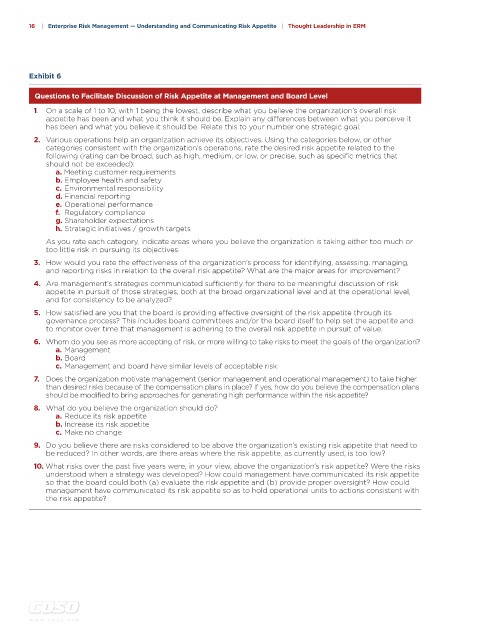Page 705 - COSO Guidance
P. 705
16 | Enterprise Risk Management — Understanding and Communicating Risk Appetite | Thought Leadership in ERM
Exhibit 6
Questions to Facilitate Discussion of Risk Appetite at Management and Board Level
1. On a scale of 1 to 10, with 1 being the lowest, describe what you believe the organization’s overall risk
appetite has been and what you think it should be. Explain any differences between what you perceive it
has been and what you believe it should be. Relate this to your number one strategic goal.
2. Various operations help an organization achieve its objectives. Using the categories below, or other
categories consistent with the organization’s operations, rate the desired risk appetite related to the
following (rating can be broad, such as high, medium, or low, or precise, such as specific metrics that
should not be exceeded):
a. Meeting customer requirements
b. Employee health and safety
c. Environmental responsibility
d. Financial reporting
e. Operational performance
f. Regulatory compliance
g. Shareholder expectations
h. Strategic initiatives / growth targets
As you rate each category, indicate areas where you believe the organization is taking either too much or
too little risk in pursuing its objectives.
3. How would you rate the effectiveness of the organization’s process for identifying, assessing, managing,
and reporting risks in relation to the overall risk appetite? What are the major areas for improvement?
4. Are management’s strategies communicated sufficiently for there to be meaningful discussion of risk
appetite in pursuit of those strategies, both at the broad organizational level and at the operational level,
and for consistency to be analyzed?
5. How satisfied are you that the board is providing effective oversight of the risk appetite through its
governance process? This includes board committees and/or the board itself to help set the appetite and
to monitor over time that management is adhering to the overall risk appetite in pursuit of value.
6. Whom do you see as more accepting of risk, or more willing to take risks to meet the goals of the organization?
a. Management
b. Board
c. Management and board have similar levels of acceptable risk
7. Does the organization motivate management (senior management and operational management) to take higher
than desired risks because of the compensation plans in place? If yes, how do you believe the compensation plans
should be modified to bring approaches for generating high performance within the risk appetite?
8. What do you believe the organization should do?
a. Reduce its risk appetite
b. Increase its risk appetite
c. Make no change
9. Do you believe there are risks considered to be above the organization’s existing risk appetite that need to
be reduced? In other words, are there areas where the risk appetite, as currently used, is too low?
10. What risks over the past five years were, in your view, above the organization’s risk appetite? Were the risks
understood when a strategy was developed? How could management have communicated its risk appetite
so that the board could both (a) evaluate the risk appetite and (b) provide proper oversight? How could
management have communicated its risk appetite so as to hold operational units to actions consistent with
the risk appetite?
w w w . c o s o . o r g

